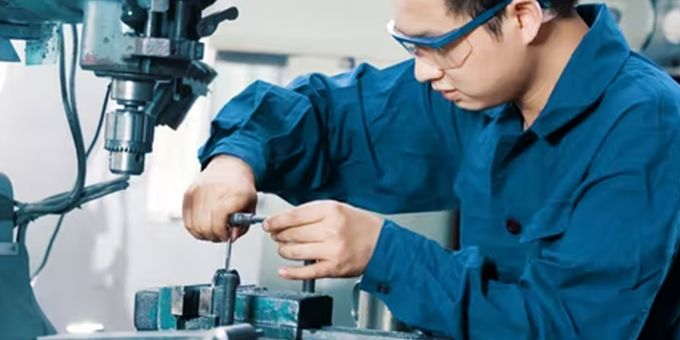Machinist shortage is a tricky problem that shop owners constantly face. Here are some ways to solve it and help you attract and retain them.
 5 Ways To Solve The Machinist Shortage
5 Ways To Solve The Machinist Shortage

Article from | Xometry
The machinist shortage is a tricky problem that applies across all areas of manufacturing, to varying degrees. Careers in manufacturing were formerly seen as a pathway to stable, interesting employment for generations. But the “service” nature of the economy and the lowered status of manufacturing and engineering (in some regions) too often make them an unattractive choice.
This appears to be more of an issue in the Anglophone world. The status of engineering and manufacturing in Asia and in much of Europe is high, reflecting the greater current focus on manufacturing as the key to wealth creation. The manufacturing industry continues to evolve at an astonishing rate, and yet it remains true that it is viewed as essentially lower status than many career paths. This creates constant challenges in recruitment, particularly at the skilled end of the workforce—and in a machine shop, deep skills are needed for many specializations.
The average age of skilled manufacturing staff is rising, and 40% of skilled manufacturing/technical staff are over 50 years old according to a report from the National Association of Manufacturers. Replacements are getting harder to find, which increases costs and delays growth. Listed below are some tips to solve the machinist shortage:
1. Showcase Your Company on Your Website and Social Media
Use your company website and social media platform to build positive perceptions. While most people recognize the need for manufacturing jobs to build the economy, far too many see those jobs as suitable for others, but not themselves. Young people aspire to emulate their peer influencers—and those people are not promoting manufacturing as exciting, satisfying, and glamorous. You may not be able to change their views on the glamor of a career as a machinist, but you know how to explain job satisfaction and even excitement.
Make sure you use the contact routes that social media and the internet offer. For example, put an opt-in for updates and make sure you do updates regularly. Keeping it live keeps people looking, and your team will take pride in the active nature of your company.
2. Tap Into National Pride in the Manufacturing Sector
Tapping into national pride in the manufacturing sector and connecting this to your brand can improve the recruitment and retention story that you’re telling. Connect with your team and let them know the important role they play in building communities. Emphasize this by adding the challenges in their roles, the training support the company can offer, and the career path opportunities and benefits. Show the competitive packages and benefits you offer. Demonstrate an inclusive and supportive company culture, such as showing your pride in your team and its work. Show people that your business has a place in the wider community.
3. Highlight the Leading-Edge Technologies
Emphasize that you’re offering a great, hi-tech place to work, countering the common view of factories as dark, menacing mills. Machinist roles are always evolving to higher tech levels, as are most manufacturing jobs. Automation affects the machine shop perhaps more than any other manufacturing workplace. Machinists/programmers are always wary of the different new aspects of their technical, high-demand skills. As a shop owner, it is critical to ensure that your machinists understand the need to upskill and adapt to new technology and advancements in the manufacturing sector.
Do this by providing constant training and skill advancements that your machinists need. Conduct annual skill assessments, and work with your shop-floor leaders and human resources (HR) to fill any gaps that have been identified. A machinist who feels valued is likely to stay longer and will work on improving their skills to be better.
4. Look to Recruitment, but Don’t Forget That You Get the Greatest Value From Retention
While it is necessary to always be on the lookout for fresh, new talents, retaining the people you have now is invaluable. If the career path works and the rewards are competitive, you’ll hold the best people longer. And this will feed back into your recruitment process because the most attractive employer is also the one with the most stable team. The attraction that holds people is the same policies and behaviors that get you ranked up the “good opportunity” reputation stakes. Additionally, the technical staff knows technical people, and if your workplace is happy, they’re among your best ambassadors.
5. Allowing Apprenticeships and Internships
Apprenticeships and internships are increasingly common staffing tools that can help solve machinist shortages. With apprenticeships, companies can solve the long-term issue, by building skills with committed, young and enthusiastic workers. The benefit is mutual, as younger and less skilled people are brought up in your culture and guided toward excellence.
Internships, on the other hand, can relieve some short-term pressure with low-skilled workers, and enable you to assess learner quality before committing. Companies can assess promising machinists who are enthusiastic, have a positive mindset, and are willing to be trained.
Tools for Improved Recruitment Experience
These are the kinds of tools you can use to increase your recruitment reach:
- Short testimonial videos.
- Showcase either your diversity or your moves toward it across as many platforms as you can find that are relevant to your locale and target groups.
- Look younger, by catching the best people as they finish some qualification—relevant or otherwise.
- Use all the routes you can to get your offer/publicity/news in front of plenty of eyes.
- Set up a candidate relationship management system/database. A CRM system will assist ROI. They help you keep track of the sometimes overwhelming recruitment process by keeping you up to date and helping you address the skills matrix gaps in your team.
Retaining and Attracting the Right Machinist for the Job
To help you meet and retain a wide spectrum of the already skilled, the parallel skilled, and the hopeful/capable, be proactive: use the right mix of strategies and media; effectively handle social and entertainment sites, and go to where people are—rather than hoping they’ll come to you. With the flexibility of approach and the use of the right tools, you can stand out in a competitive environment and get the attention of the right kind of candidates, in numbers that give you options in building your team.
The content & opinions in this article are the author’s and do not necessarily represent the views of ManufacturingTomorrow
Comments (0)
This post does not have any comments. Be the first to leave a comment below.
Featured Product

